Cuban Missile Crisis
At the beginning of September 1962, U-2 spy planes discovered that the Soviet Union was building surface-to-air missile (SAM) launch sites. There was also an increase in the number of Soviet ships arriving in Cuba which the United States government feared were carrying new supplies of weapons. President John F. Kennedy complained to the Soviet Union about these developments and warned them that the United States would not accept offensive weapons (SAMs were considered to be defensive) in Cuba.
As the Cubans now had SAM installations they were in a position to shoot down U-2 spy-planes. Kennedy was in a difficult situation. Elections were to take place for the United States Congress in two month's time. The public opinion polls showed that his own ratings had fallen to their lowest point since he became president.
In his first two years of office a combination of Republicans and conservative southern Democrats in Congress had blocked much of Kennedy's proposed legislation. The polls suggested that after the elections he would have even less support in Congress. Kennedy feared that any trouble over Cuba would lose the Democratic Party even more votes, as it would remind voters of the Bay of Pigs disaster where the CIA had tried to oust Fidel Castro from power. One poll showed that over 62 per cent of the population were unhappy with his policies on Cuba. Understandably, the Republicans attempted to make Cuba the main issue in the campaign.
This was probably in Kennedy's mind when he decided to restrict the flights of the U-2 planes over Cuba. Pilots were also told to avoid flying the whole length of the island. Kennedy hoped this would ensure that a U-2 plane would not be shot down, and would prevent Cuba becoming a major issue during the election campaign.
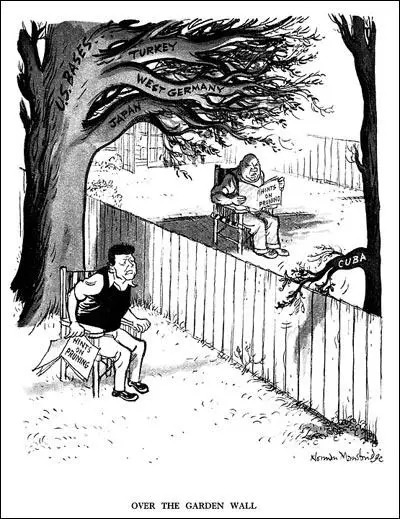
On 27th September, a CIA agent in Cuba overheard Castro's personal pilot tell another man in a bar that Cuba now had nuclear weapons. U-2 spy-plane photographs also showed that unusual activity was taking place at San Cristobal. However, it was not until 15th October that photographs were taken that revealed that the Soviet Union was placing long range missiles in Cuba.
President Kennedy's first reaction to the information about the missiles in Cuba was to call a meeting to discuss what should be done. Robert S McNamara, Secretary of State for Defence, suggested the formation of the Executive Committee of the National Security Council. Fourteen men attended the meeting and included military leaders, experts on Latin America, representatives of the CIA, cabinet ministers and personal friends whose advice Kennedy valued. Over the next few days they were to meet several times. During their discussions they considered several different strategies for dealing with the crisis. They included the following:.
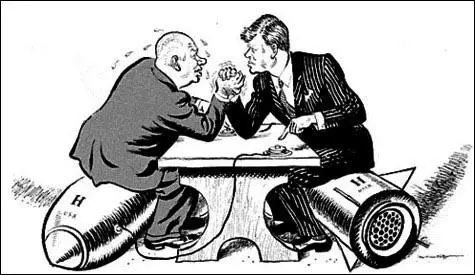
(1) Do nothing. The United States should ignore the missiles in Cuba. The United States had military bases in 127 different countries including Cuba. The United States also had nuclear missiles in several countries close to the Soviet Union. It was therefore only right that the Soviet Union should be allowed to place missiles in Cuba.
(2) Negotiate. The United States should offer the Soviet Union a deal. In return for the Soviet Union dismantling her missiles in Cuba, the United States would withdraw her nuclear missiles from Turkey and Italy.
(3) Invasion. Send United States troops to Cuba to overthrow Castro's government. The missiles could then be put out of action and the Soviet Union could no longer use Cuba as a military base.
(4) Blockade of Cuba. Use the United States Navy to stop military equipment reaching Cuba from the Soviet Union.
(5) Bomb Missile Bases. Carry out conventional air-strikes against missiles and other military targets in Cuba.
(6) Nuclear Weapons. Use nuclear weapons against Cuba and/or the Soviet Union.
When discussing these strategies. President Kennedy and his advisers had to take into consideration how the Soviet Union and Cuba would react to decisions made by the United States.
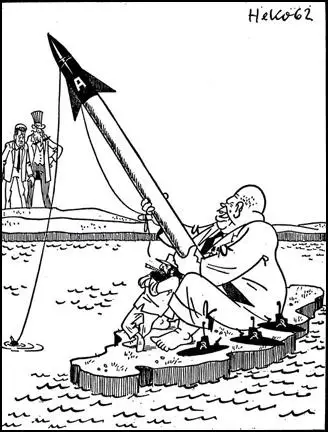
At the first meeting of the Executive Committee of the National Security Council, the CIA and other military advisers explained the situation. After hearing what they had to say, the general feeling of the meeting was for an air-attack on the missile sites. Remembering the poor advice the CIA had provided before the Bay of Pigs invasion, John F. Kennedy decided to wait and instead called for another meeting to take place that evening. By this time several of the men were having doubts about the wisdom of a bombing raid, fearing that it would lead to a nuclear war with the Soviet Union. The committee was now so divided that a firm decision could not be made.
The Executive Committee of the National Security Council argued amongst themselves for the next two days. The CIA and the military were still in favour of a bombing raid and/or an invasion. However, the majority of the committee gradually began to favour a naval blockade of Cuba.
Kennedy accepted their decision and instructed Theodore Sorensen, a member of the committee, to write a speech in which Kennedy would explain to the world why it was necessary to impose a naval blockade of Cuba.
As well as imposing a naval blockade, Kennedy also told the air-force to prepare for attacks on Cuba and the Soviet Union. The army positioned 125,000 men in Florida and was told to wait for orders to invade Cuba. If the Soviet ships carrying weapons for Cuba did not turn back or refused to be searched, a war was likely to begin. Kennedy also promised his military advisers that if one of the U-2 spy planes were fired upon he would give orders for an attack on the Cuban SAM missile sites.
The world waited anxiously. A public opinion poll in the United States revealed that three out of five people expected fighting to break out between the two sides. There were angry demonstrations outside the American Embassy in London as people protested about the possibility of nuclear war. Demonstrations also took place in other cities in Europe. However, in the United States, polls suggested that the vast majority supported Kennedy's action.
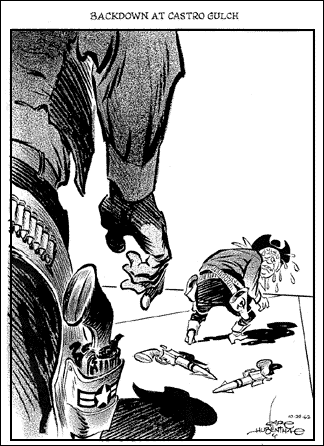
On October 24, President John F. Kennedy was informed that Soviet ships had stopped just before they reached the United States ships blockading Cuba. That evening Nikita Khrushchev sent an angry note to Kennedy accusing him of creating a crisis to help the Democratic Party win the forthcoming election.
On October 26, Khrushchev sent Kennedy another letter. In this he proposed that the Soviet Union would be willing to remove the missiles in Cuba in exchange for a promise by the United States that they would not invade Cuba. The next day a second letter from Khrushchev arrived demanding that the United States remove their nuclear bases in Turkey.
While the president and his advisers were analyzing Khrushchev's two letters, news came through that a U-2 plane had been shot down over Cuba. The leaders of the military, reminding Kennedy of the promise he had made, argued that he should now give orders for the bombing of Cuba. Kennedy refused and instead sent a letter to Khrushchev accepting the terms of his first letter.
Khrushchev agreed and gave orders for the missiles to be dismantled. Eight days later the elections for Congress took place. The Democrats increased their majority and it was estimated that Kennedy would now have an extra twelve supporters in Congress for his policies.
The Cuban Missile Crisis was the first and only nuclear confrontation between the United States and the Soviet Union. The event appeared to frighten both sides and it marked a change in the development of the Cold War. Some of the direct consequences of the crisis include the following:
(1) The two sides established a direct communications link that became known as the Hot Line. It was hoped that this would help prevent dangerous confrontations such as the Cuban Missile Crisis arising again.
(2) Three months after the Cuban Missile Crisis the United States secretly removed all its nuclear missiles from Turkey and Italy.
(3) A Test Ban Treaty was signed between the two countries in August 1963. The treaty prohibited the testing of nuclear weapons in the atmosphere.
(4) The 1,113 prisoners captured during the Bay of Pigs invasion were exchanged by Castro for $60 million in food, drugs, medicine and cash.
(5) The Soviet Union became determined to have a nuclear capability that was equal to the United States. This was achieved by 1972.
(6) China accused the Soviet Union of being a 'paper-tiger' and claimed to be the true leader of the Communist movement. The split between the Soviet Union and China became wider.
(7) The United States became convinced that the Soviet Union would not go to war over another communist country. It has been argued that this encouraged the United States to help attempts to overthrow socialist and communist governments in Vietnam, Nicaragua and Grenada.
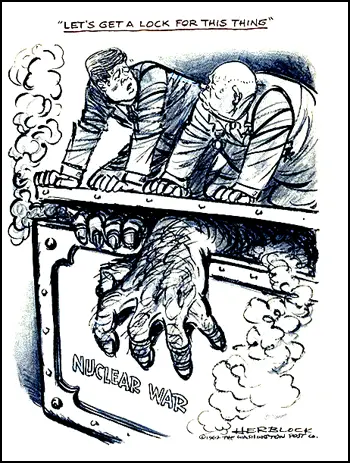
Primary Sources
(1) Andrei Gromyko, the Soviet Union's foreign secretary, book Through Russian Eyes: President Kennedy's 1036 Days was published in 1973. In the book Gromyko wrote about the background to the Cuban Missile Crisis.
The United States over several years had established offensive military bases around the socialist countries and, primarily, near the USSR borders... the placement of medium-range effective Soviet missiles in Cuba was undertaken only after the United States ruling circles continually rejected proposals to remove American military bases, including missile sites, on foreign territory.
(2) In 1984 Fidel Castro was interviewed by the American journalist, Tad Szulc. The journalist asked Castro why he was willing to allow Soviet missiles to be placed in Cuba.
It was necessary to make it clear to the United States that an invasion of Cuba would imply a war with the Soviet Union. It was then that they proposed the missiles... We preferred the risks, whatever they were, of a great tension, a great crisis, to the risks of the impotence of having to await a United States invasion of Cuba.
(3) In his autobiography, Khrushchev Remembers, published in 1971, Nikita Khrushchev explained why the missiles were placed in Cuba.
The United States had already surrounded the Soviet Union with its own bomber bases and missiles. We knew that American missiles were aimed against us in Turkey and Italy, to say nothing of West Germany. It was during my visit to Bulgaria that I had the idea of installing missiles with nuclear warheads in Cuba without letting the United States find out they were there until it was too late to do anything about them. Everyone agreed that America would not leave Cuba alone unless we did something. We had an obligation to do everything in our power to protect Cuba's existence as a Socialist country and as a working example to the other countries in Latin America... The Americans had surrounded our country with military bases and threatened us with nuclear weapons and now they would learn just what it feels like to have enemy missiles pointing at you; we'd be doing nothing more than giving them a little of their own medicine.
(4) Terence Cannon, Revolutionary Cuba (1981)
Convinced that Cuba faced an imminent attack by an overwhelmingly superior force, the revolutionary government sent Che Guevara to Moscow to request nuclear missiles with which to defend their country The Soviet Union agreed.
(5) Theodore Sorensen was a close friend and a political adviser to President John F. Kennedy. In his biography of Kennedy, Sorensen explains what the president and his advisers believed to be the reasons for the missiles being placed in Cuba.
Convinced that Cuba faced an imminent attack by an overwhelmingly superior force, the revolutionary government sent Che Guevara to Moscow to request nuclear missiles with which to defend their country The Soviet Union agreed.
(6) David Detzer is an American historian. His book The Brink: The Cuban Missile Crisis, was published in 1980.
One wonders, given Russian reluctance to move nuclear weapons from Soviet soil, if in fact they merely sent rockets and non-nuclear warheads. If the Kremlin's purpose was essentially political (for example, Berlin), all they needed to do was to give the appearance of nuclear capability. Moreover, sending atomic warheads to Cuba offered certain disadvantages. Something might go wrong - such as a ship sinking or a misfire, or even the Cuban government grabbing them. It seems at least possible that the Russians were bluffing.
(7) James Daniel and John Hubbell are two historians who wrote a book about the Cuban Missile Crisis. In their book, Strike in the West, the Complete Story of the Cuban Crisis (1963) they comment on why they believed the missiles were placed in Cuba.
The United States anticipated that by the mid-sixties they would have in the neighbourhood of 1,500 ballistic missiles... The total number of Soviet missiles which could reach targets in the United States was about 125... But by moving medium and intermediate-range missiles to Cuba, deep in the Western Hemisphere, Russia was rapidly narrowing the gap... The presence of Russian missiles in Cuba had drastically altered the balance of world power.
(8) On October 22,1962 President John F. Kennedy made a speech to the nation on radio and television about the Soviet missiles in Cuba. Below is an edited version of the speech.
Good evening, my fellow citizens. This Government, as promised, has maintained the closest surveillance of the Soviet military buildup on the island of Cuba. Within the past week, unmistakable evidence has established the fact that a series of offensive missile sites is now in preparation on that imprisoned island. The purpose of these bases can be none other than to provide a nuclear strike capability against the Western Hemisphere.
The characteristics of these new missile sites indicate two distinct types of installations. Several of them include medium range ballistic missiles, capable of carrying a nuclear warhead for a distance of more than 1,000 nautical miles. Each of these missiles, in short, is capable of striking Washington, D.C., the Panama Canal, Cape Canaveral, Mexico City, or any other city in the south-eastern part of the United States, in Central America, or in the Caribbean area.
To halt this offensive buildup, a strict quarantine on all offensive military equipment under shipment to Cuba is being initiated. All ships of any kind bound for Cuba from whatever nation or port will, if found to contain cargoes of offensive weapons, be turned back... We are not at this time, however, denying the necessities of life as the Soviets attempted to do in their Berlin blockade of 1948.
(9) Walter Trohan wrote about the Cuban Missile Crisis in the New York Tribune in November 1962.
For the first time in twenty years Americans can carry their head high because the president of the United States had stood up to the premier of Russia and made him back down.
(10) Mario Lazo, a Cuban lawyer was a supporter of the Batista regime that was overthrown by Castro. After the Cuban revolution he fled to the United States. In 1968 he wrote a book calle Dagger in the Heart: American Failures in Cuba.
The accounts of the crisis did not make clear that it was a power confrontation, that the power of the USA was incomparably superior to that of the USSR, and that the leaders of both nations knew this to be a fact. The United States, it is worth repeating, could have erased every important Soviet military installation and population centre in two or three hours while the strike capability of the USSR was negligible. Although Kennedy held the trump cards, he granted the Communist Empire a privileged sanctuary in the Caribbean by means of the "no invasion" pledge.
(11) I. F. Stone, a journalist, wrote an article on Kennedy after he was assassinated in 1963.
What if the Russians had refused to back down and remove their missiles from Cuba? What if they had called our bluff and war had begun, and escalated? How would the historians of mankind, if a fragment survived, have regarded the events of October?... Since this is the kind of bluff that can easily be played once too often, and that his successors may feel urged to imitate, it would be well to think it over carefully before canonizing Kennedy as an apostle of peace.
(12) Ambassador Dobrynin's Cable to the Soviet Foreign Ministry (27th October 1962)
Late tonight R. Kennedy invited me to come see him. We talked alone. The Cuban crisis, R. Kennedy began, continues to quickly worsen....
"And what about Turkey?" I asked R. Kennedy. "If that is the only obstacle to achieving the regulation I mentioned earlier, then the president doesn't see any unsurmountable difficulties in resolving this issue," replied R. Kennedy. "The greatest difficulty for the president is the public discussion of the issue of Turkey. Formally the deployment of missile bases in Turkey was done by a special decision of the NATO Council. To announce now a unilateral decision by the president of the USA to withdraw missile bases from Turkey - this would damage the entire structure of NATO and the US position as the leader of NATO, where, as the Soviet government knows very well, there are many arguments. In short, if such a decision were announced now it would seriously tear apart NATO." "However, President Kennedy is ready to come to agree on that question with N.S. Khrushchev, too. I think that in order to withdraw these bases from Turkey," R. Kennedy said, "we need 4-5 months. This is the minimal amount of time necessary for the US government to do this, taking into account the procedures that exist within the NATO framework. On the whole Turkey issue," R. Kennedy added, "if Premier NS Khrushchev agrees with what I've said, we can continue to exchange opinions between him and the president, using him, R. Kennedy and the Soviet ambassador. "However, the president can't say anything public in this regard about Turkey," R. Kennedy said again. R. Kennedy then warned that his comments about Turkey are extremely confidential; besides him and his brother, only 2-3 people know about it in Washington. "That's all that he asked me to pass on to NS Khrushchev," R. Kennedy said in conclusion. "The president also asked NS Khrushchev to give him an answer (through the Soviet ambassador and R. Kennedy) if possible within the next day.
(13) Theodore Sorensen, interviewed in 1989.
Kennedy recognized that, for Chairman Khrushchev to withdraw the missiles from Cuba, it would be undoubtedly helpful to him if he could say at the same time to his colleagues on the Presidium, "And we have been assured that the missiles will be coming out of Turkey." And so, after the ExComm meeting (on the evening of 27 October 1962), as I'm sure almost all of you know, a small group met in President Kennedy's office, and he instructed Robert Kennedy - at the suggestion of Secretary of State Dean Rusk - to deliver the letter to Ambassador Dobrynin for referral to Chairman Khrushchev, but to add orally what was not in the letter: that the missiles would come out of Turkey. Ambassador Dobrynin felt that Robert Kennedy's book did not adequately express that the "deal" on the Turkish missiles was part of the resolution of the crisis. And here I have a confession to make to my colleagues on the American side, as well as to others who are present. I was the editor of Robert Kennedy's book. It was, in fact, a diary of those thirteen days. And his diary was very explicit that this was part of the deal; but at that time it was still a secret even on the American side, except for the six of us who had been present at that meeting. So I took it upon myself to edit that out of his diaries, and that is why the Ambassador is somewhat justified in saying that the diaries are not as explicit as his conversation.
